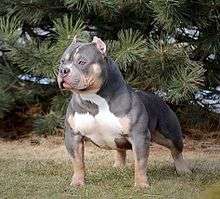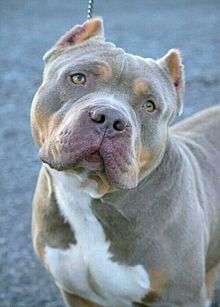American Bully
 American Bully | |||||||||||||||||||||||||||||
| Common nicknames |
Am. Bull Bully | ||||||||||||||||||||||||||||
|---|---|---|---|---|---|---|---|---|---|---|---|---|---|---|---|---|---|---|---|---|---|---|---|---|---|---|---|---|---|
| Origin | United States | ||||||||||||||||||||||||||||
| |||||||||||||||||||||||||||||
| |||||||||||||||||||||||||||||
| Domestic dog (Canis lupus familiaris) | |||||||||||||||||||||||||||||
The American Bully is a recently formed companion dog breed,[1] originally recognized by the American Bully Kennel Club (ABKC). It has been recognized by the United Kennel Club (UKC) since July 15, 2013.[2] It is a small to large breed which has been divided into four categories; Pocket, Standard, Classic and XL.
History
Founded in the United States between 1980 and 1990, the American Bully was produced using a foundation of American Staffordshire Terriers and American Pit Bull Terrier. Was created with the purpose to be the ultimate family's companion dog.[3][4]
While some of the founding kennels, namely Razor's Edge owner Dave Wilson, affirmed that used only these breeds to produce the desired dogs, it is speculated that five other breeds were used to attain the more "bully" physical traits desired. These are best guessed to by the American Bulldog, English Bulldog, Olde English Bulldogge, Staffordshire Bull Terrier and French Bulldog.[5]
The initial desire for this breed was to produce a dog with a lower drive than the American Pit Bull Terrier, while also displaying more of the "bully" traits than the American Staffordshire Terrier. Mass and heavy bone was prioritised to ensure such a look, and due to this many of the dogs shown today display the wide front for which they were originally bred.
The breed was first recognised by its breed club, the American Bully Kennel Club, in 2004.[6] This registry first acted as a means to document pedigrees and show the breed against its written standard.

During the early years of the breed, a wide spectrum of dogs were shown, many displaying physical traits of the other introduced breeds; these were penalized heavily by the registry, forcing owners and breeders of such dogs to create new means to show their style of dog without being rejected.
Varieties
Within the ABKC, the four varieties are separated by height without specification of weight. All these varieties are expected to follow the same standard with minor alterations.[7]
All dogs are classified and shown as Standard until they reach a year of age, at which point they are separated into the varieties and shown against their own type.
Classic
The original American Bully style is the Classic; these dogs do not display the exaggerated features often found in the other varieties, and arguably display clearer American Pit Bull Terrier/American Staffordshire Terrier lineage.

The Classic is a lighter frame dog than the Standard but falls within the same height range; male dogs must be 17 to 20 in (43 to 51 cm) while females must be 16 to 19 in (41 to 48 cm).
Standard
The Standard type is a compact, muscular dog with a large blocky head; this is arguably the most popular type alongside the Pocket type.
The most commonly seen of the varieties, the Pocket males are 14 to 17 in (36 to 43 cm) while females are 13 to 16 in (33 to 41 cm) at the withers.
XL
Arguably the type showing the greatest diversity in appearance, the XL is the largest variety ranging from 19 to 22 in (48 to 56 cm)) in females and 20 to 23 in (51 to 58 cm) in males. These tend to be heavily muscled, impressive dogs.
Unofficial types
Outside of the breed standard dogs shorter or taller than named, and, more exaggerated dogs have been bred under the American Bully name. Smaller dogs are sometimes called "Micro" and larger ones are called "XXL", but neither are recognized by the kennel clubs as legitimate varieties. Previously a fifth category was accepted, Extreme, however as the breed is intended to be an exaggerated breed the ABKC removed the category for show purposes.
There has been an increase in interest in the Exotic type dogs and breedings. These dogs are often shorter than Pocket variety and display features closer to the French Bulldog; many of which, when uncropped, display the characteristic "bat ears". These dogs are often shown through non-affiliated registries for those who prefer the type, though they are known for an increase in health problems and shortened lifespan.

Temperament
The American Bully is a highly adaptable breed, often acting as a laid back companion dog in the home while showing a zest for life and energy while outside. Many dogs, despite acting as lap dogs in the home, do well in sports such as weight pull and spring pole. Despite excelling in such sports and public misconception, dog and human aggression is discouraged and seldom seen in the breed; however, as the breed is still in the late stages of standardisation, this can vary between kennels and individual dogs.
Health
Health problems vary within the breed, and span the entire spectrum; with some varieties (namely the Exotic) being plagued by problems, and others being well documented for health and quality.
Testing is not as common place in the breed as in older breeds; though hip and elbow scoring are the most frequently conducted.
Cherry eye, ectropion and entropion are often seen affecting the eyes; while Brachycephalic Respiratory Syndrome can be seen in the shorter muzzled dogs.
Breed-specific legislation
Despite their well known lineage, the American Bully is not subjected to Breed-specific legislation and does not fall within the "pitbull type" parameters. As such, the Bully is often popular as an alternative in countries where such measures are in place.
Controversy
Cropping
Ear cropping is common practice in the breed, and often mis-connected with dog fighting activities. The cropping of this breed, arguably, aids in producing the established aesthetic of the breed. Though the majority of titled Bullies are cropped, both the ABKC and UKC standards state that both cropped and natural ears can be shown, as long as they are not pricked (erect).
In countries where cropping is banned, natural eared dogs are commonly seen at conformation shows; these dogs often sport rose, drop and button ears, the latter two of which are penalized by the UKC.
External links
| Wikimedia Commons has media related to American Bully. |